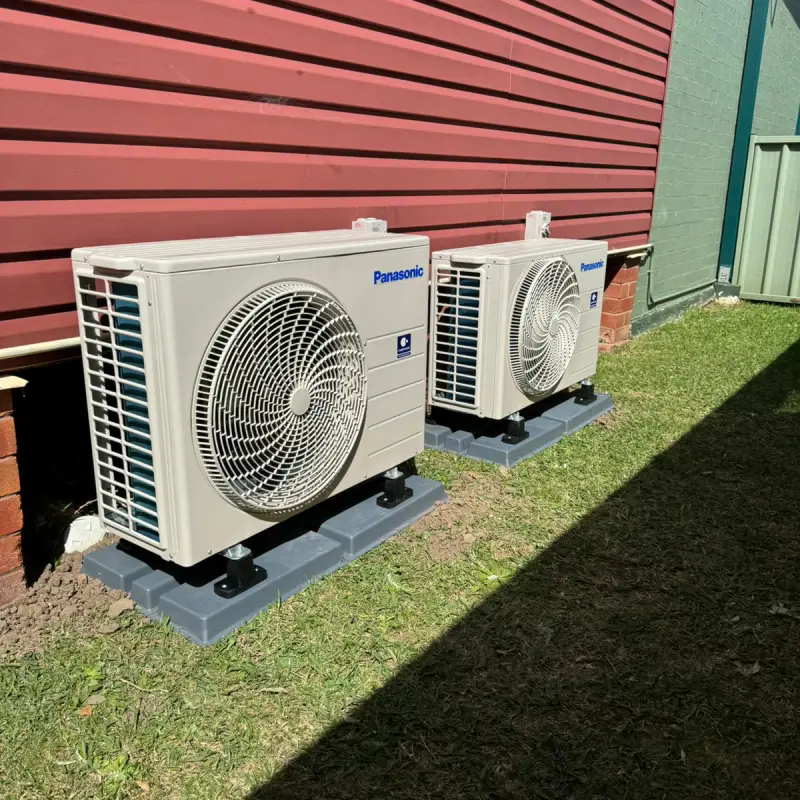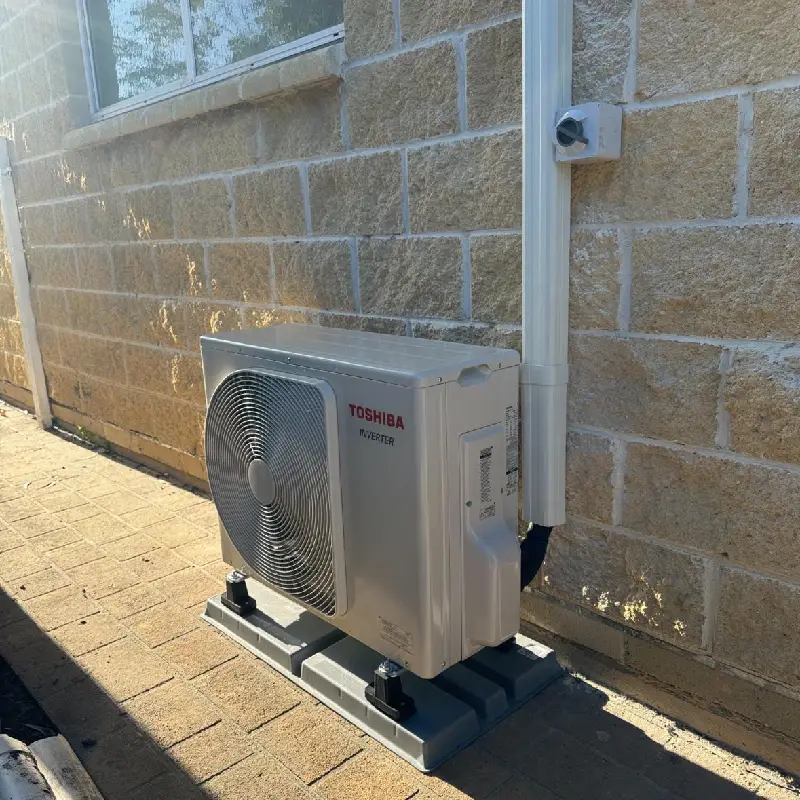If you live in a smaller home or apartment, a split system is ideal—it cools specific areas, like a bedroom, living room, or office. You won’t need a large system to keep your space comfortable.
Split vs Ducted System: Which is Best?
Are you feeling overwhelmed by the wide range of air conditioning options available? It’s a common struggle for many homeowners. As the seasons change and you seek comfort in your home, selecting the right air conditioning system can feel like a daunting decision. You might find yourself asking, “What should I choose between a ducted air conditioning vs split system?” Both have their unique benefits and drawbacks, making it important to identify which one best suits your needs.
At Chilko AIR, we understand how crucial it is to make an informed choice for your comfort and budget. That’s why we’re here to help. In this blog, you’ll find a clear and comprehensive comparison of ducted vs split systems to guide your decision.
By the end of this article, you’ll have a clear picture of how both systems work. You’ll know what they cost, how they’re installed, how efficient they are, and which one fits your home and lifestyle best.
This article will explore the ideal cooling and/or heating solution for your home.
What is a Ducted Air Conditioning System?
A ducted air conditioning system is a whole-home solution designed to deliver consistent heating and cooling across multiple rooms or your entire house. The system includes a central unit, usually installed in the roof or outside your home, connected to a series of ducts that distribute air through vents in your ceilings or walls.
This setup is popular for its discreet design, as only the vents are visible in your living spaces. Modern ducted systems also offer zoning capabilities, allowing you to control the temperature in specific areas of your home. This can enhance comfort and reduce energy waste by focusing on the spaces you use the most.
Ducted systems are ideal for large homes or households that want seamless temperature control without needing multiple units. However, the convenience comes with a higher initial investment and a more complex installation process, as it requires modifications to accommodate the ductwork.
What is a Split System Air Conditioner?
A split system air conditioner is a versatile and cost-effective cooling and heating option, perfect for individual rooms or specific areas in your home. As its name suggests, the system is divided into two main components: an indoor unit and an outdoor unit.
The indoor unit is typically mounted on a wall within the room you wish to heat or cool, and it distributes conditioned air directly into the space. The outdoor unit, installed outside your home, houses the compressor and condenser. The two units are connected by refrigerant piping, which ensures efficient temperature control.
Split systems are known for their ease of installation and affordability compared to ducted systems. They are an excellent choice for small to medium-sized homes, rental properties, or anyone who needs a targeted heating and cooling solution. Plus, modern models often include inverter technology, enabling energy-efficient operation with precise temperature control.
That said, split systems are limited to single-room coverage, and multiple units may be required for larger homes, which can impact aesthetics and increase overall costs.
Pros and Cons of Ducted Systems
| Pros | Cons |
| Whole-Home Temperature Control: Provides consistent heating and cooling across your entire home. | Higher Upfront Costs: More expensive to purchase and install, typically costing $10,000–$14,000 supplied and installed |
| Discreet Design: Components are hidden within the ceiling or walls, with only vents visible. | Complex Installation: Requires modifications to ceilings or walls for grills/ac vents, needing professional installation. |
| Zoning Capabilities: Allows temperature control in specific zones, improving comfort and reducing energy waste. | Energy Usage: Cooling or heating the whole house can increase energy bills if zoning isn’t used effectively. |
| Enhanced Property Value: Adds value to your home, making it more appealing to potential buyers. | Not Suitable for All Homes: Homes with limited ceiling or under-floor space may not be able to accommodate ducted systems. |
Ducted systems are an excellent choice for homeowners seeking a streamlined, whole-home solution and who don’t mind the higher upfront investment. If your home is suitable for the installation and you value consistent comfort, this system could be worth considering.
Pros and Cons of Split Systems
Split system air conditioners are a popular choice for homeowners seeking a targeted and cost-effective cooling and heating solution. Here’s a detailed look at the benefits and drawbacks
| Pros | Cons |
| Cost-Effective Installation: Generally cheaper and easier to install, with prices ranging from $2,000 to $3,400 per unit supplied and installed | Limited Coverage: Designed for single rooms or small areas, requiring multiple units for larger homes. |
| Flexibility: Allows targeted heating or cooling in specific rooms, giving you control over where you use the system. | Aesthetic Impact: Wall-mounted indoor units can be visually intrusive. |
| Energy Efficiency: Only heats or cools rooms in use, which can lower energy consumption and electricity bills. | Installation Type Matters: Installation costs can increase if the indoor and outdoor units aren’t positioned back-to-back. |
| Easy Maintenance: Maintenance is simpler and less costly, typically requiring annual servicing at $100–$200 per unit. | Space Requirements: Requires outdoor space for the external unit, which may be a challenge for some homes. |
Split systems are an ideal solution for smaller homes or spaces where budget and flexibility are key considerations. While they may not suit larger homes without multiple units, their affordability and targeted efficiency make them a highly attractive option for many households.
Cost Comparison
One of the most critical factors when choosing between a ducted and a split system is cost. Understanding both the upfront and long-term expenses associated with each option can help you make the best financial decision for your home. Here’s a breakdown of a ducted vs split system running cost:
| System Type | Upfront Costs | Long-Term Costs |
| Ducted Systems | Unit and installation costs range from $10,000 to $14,000, depending on home size and complexity. | Higher running costs if the whole house is cooled or heated regularly. Annual maintenance costs range from $200 to $500. Zoning can reduce long-term expenses. |
| Split Systems | Unit and installation costs range from $2,000 to $3,400 per unit, based on unit capacity and features. | Lower running costs due to targeted usage. Annual maintenance typically costs $100 to $200 per unit. Multiple units may increase costs. |
Key Considerations
- Ducted Systems
- Ideal for large homes with consistent temperature needs across multiple rooms.
- While initial investment is high, zoning features can help manage energy usage and costs over time.
- Split Systems
- Best suited for smaller homes or households with selective cooling/heating needs.
- Even with multiple units, the overall cost can remain competitive for homes with limited spaces to heat or cool.
By weighing the upfront installation costs against the ongoing energy and maintenance expenses, you can determine which system aligns better with your budget and usage needs.
Installation Considerations
When installing a ducted or split system, there are several factors to consider, from complexity and cost to how the process impacts your home. Here’s a side-by-side comparison of what to expect with each system:
| System Type | Installation Process | Timeframe | Professional Requirements |
| Ducted Systems | Requires significant modifications to your home, including installing ducts in ceilings or walls. | Installation can take several days, depending on the size of the home and system complexity. | Professional installation is mandatory to ensure proper system design and functionality. |
| Split Systems | Involves mounting an indoor unit and connecting it to the outdoor unit via refrigerant piping. | Typically completed within a few hours to one day per unit, causing minimal disruption. | While simpler, professional installation is recommended for efficiency and warranty compliance. |
Key Considerations
- Ducted Systems
- Installation is more invasive, requiring sufficient roof or wall space for ducting and vents.
- Homes with unique designs or limited space may not be suitable for ducted systems.
- Split Systems
- Easier and less disruptive to install, with minimal modifications to your home.
- Positioning matters; “back-to-back” installations, where the indoor and outdoor units are on the same wall, minimise costs.
Ducted systems demand more preparation and time but provide a streamlined, whole-home solution. Split systems, on the other hand, are quicker to set up and ideal for targeted heating or cooling.
Energy Efficiency and Environmental Impact
Energy efficiency is a crucial factor when deciding between a ducted and split system, as it directly affects your electricity bills and environmental footprint. Here’s how the two systems compare in terms of efficiency and sustainability:
| System Type | Energy Efficiency | Environmental Impact |
| Ducted Systems | Can heat or cool the entire house, which may lead to higher energy consumption if zoning isn’t used effectively. | Modern systems use eco-friendly refrigerants like R32, which have a lower global warming potential (GWP). |
| Split Systems | Targeted heating and cooling for specific rooms make split systems more energy-efficient for smaller spaces. | Many split systems also use environmentally friendly refrigerants and come with high Energy Star ratings. |
Key Considerations
- Ducted Systems
- Zoning: Improves energy efficiency by allowing you to control temperatures in specific areas, reducing unnecessary usage.
- Whole-Home Coverage: Efficient for large households where multiple rooms are used simultaneously but less so for sporadic usage.
- Split Systems
- Targeted Efficiency: By cooling or heating only the rooms in use, split systems significantly reduce energy wastage.
- Inverter Technology: Many models adjust the compressor speed to maintain consistent temperatures, boosting efficiency and comfort.
Environmental Benefits:
Both systems are increasingly adopting environmentally friendly refrigerants and technologies to lower their environmental impact. Look for systems with high Energy Star ratings to maximise energy savings and reduce your carbon footprint.
Ducted or Split System? We’ve Got You Covered.
Deciding between a ducted and split air conditioning system ultimately depends on your home, budget, and lifestyle. If you’re after seamless whole-home cooling and heating and are prepared for a higher upfront investment, a ducted system may be the way to go. On the other hand, if you want an affordable, energy-efficient solution for specific rooms, a split system could be your perfect match.
Here’s a quick recap to guide your decision:
- Ducted systems are ideal for large homes or those needing consistent temperatures throughout, offering discreet installation and zoning capabilities.
- Split systems excel in smaller homes or for homeowners who prefer targeted cooling and heating, with lower installation costs and energy-efficient operation.
Ready to Choose?
At Chilko AIR, we’re here to make your decision as stress-free as possible. Our team of air conditioning experts can help you evaluate your home and recommend the system that best fits your needs. From installation to ongoing maintenance, we’ve got you covered to ensure your home stays comfortable year-round.
Contact us today to discuss your options or get a free quote!







